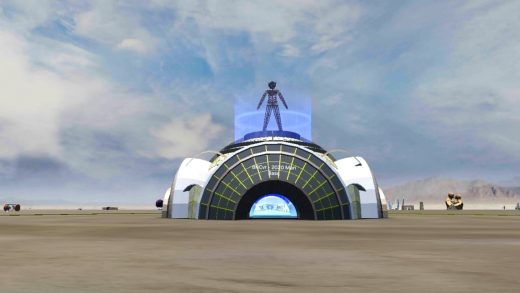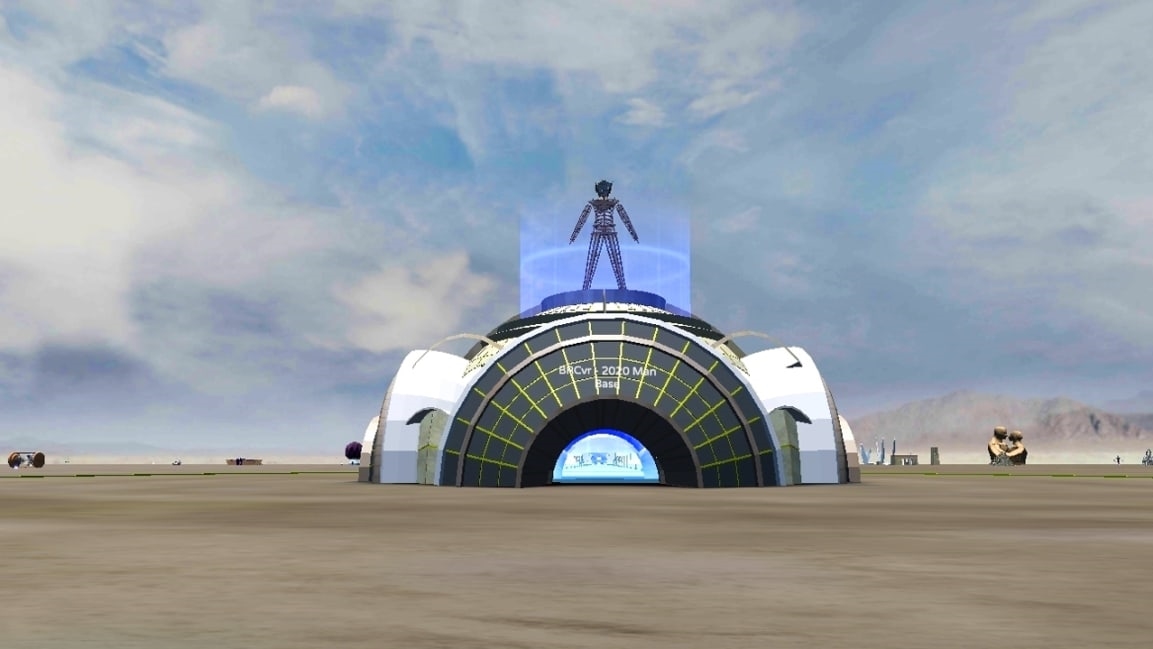I was skeptical about attending Burning Man in VR, but it’s great
For anyone who’s ever been to Burning Man, a signature experience is setting off from point A with some friends, fully intent on getting to point B—an art piece, a theme camp, a dance party—and never making it because . . . Squirrel! And you couldn’t be happier about it.
And this week, as I prowled with friends in BRCvr, the virtual Burning Man that is serving as a COVID-era replacement for the annual desert bacchanalia, we kept getting distracted in that familiar, reassuring way.
As a 21-time Burning Man veteran, I had been heartbroken, but not at all surprised, by the cancellation of the 2020 event. There was no way 80,000 people could gather in Black Rock City (BRC), Burning Man’s temporary urban home in the Nevada desert, during a global pandemic.
Still, when I first heard about Multiverse, the Burning Man Organization’s concept for a fully-digital alternative experience comprising eight discrete virtual worlds across a mishmash of computing platforms, I was skeptical. I tried volunteering for an associated event in late spring, and it was a miserable failure of distracted Zooming, technology collapse, and pure boredom. It did not augur well for Multiverse.
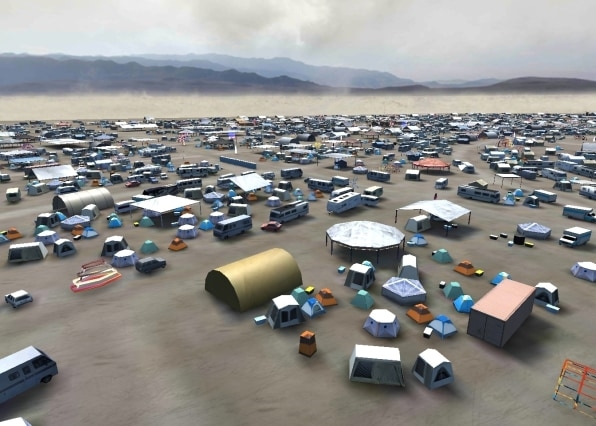
But spring went by and summer began, and then quickly, it was the week before Labor Day. I knew I couldn’t stay away. So I strapped on my VR headset and dived into BRCvr, fully expecting to give up after a few minutes, vindicated in my skepticism.
And then, the unexpected happened.
BRCvr’s main entry point is a spot out in the open, just a few dozen virtual meters away from what any Burning Man veteran instantly recognizes as the Center Camp Café, the beating-heart hub of Black Rock City. A good start: Things looked right. They sounded right, too. I heard the sound of a blast from a fire cannon. I heard laughter. And I heard people nearby having random conversations.
I turned to my left, and there, just a few meters away, was the Duck, a converted golf cart some friends of mine converted to look like a big rubber duck. I have spent an uncountable number of hours riding around on it over the years. It was pure serendipity that it was just about the first thing I saw—but as any Burner knows, that’s the type of serendipity that happens all the time in BRC. This was a very good sign. And it was just the beginning.
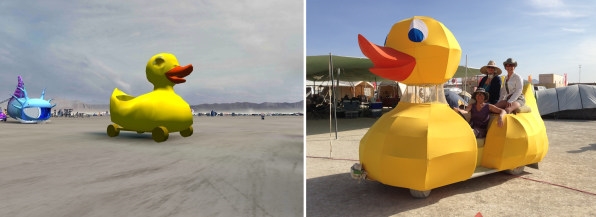
[Screenshot: Daniel Terdiman; photo: Ted Hullar]
This year saw the cancellation or postponement of pretty much all in-person events around the world. And many, like SXSW, Coachella, and of course, Burning Man, have built deeply entrenched communities. Each risked dying if they couldn’t find some way to give their constituencies at least some taste of what they were missing. But how to do so in an environment when people can’t physically congregate? A bunch of themed Zooms might have cut it last April, but not after the many months of Brady Bunch square videoconferences we’ve all done.
The lessons of a great virtual event
The Red Rocks music festival tried one approach last week, with an interactive live-streamed performance by bands playing onstage that allowed fans to participate in a small but meaningful way.
But based on the fun I had in BRCvr over several days of playing in it, I’d argue that Burning Man’s Multiverse is the model that other events should study, and if possible, emulate. It’s left us longtime burners talking about how it feels just like—well, at least a lot like—Burning Man. And that is no easy trick. So what are the lessons?
First, event organizers need to find a way to remind people of what they experience at the traditional version of an event. BRCvr’s designers achieved that seemingly impossible goal by building an all-digital “playa”—what Burners call the physical space of Burning Man—that mimics the scale and scope of the real playa. In VR, you can walk at more or less the same speed as you do in real life and experience an environment that’s the same “size” as the real space. So as BRCvr participants, we found ourselves standing in the middle of a giant playa, with the right ambient sound piping in through our VR headsets or headphones, with whimsical art pieces all around us and strangers and friends to meet up with or run into by accident.
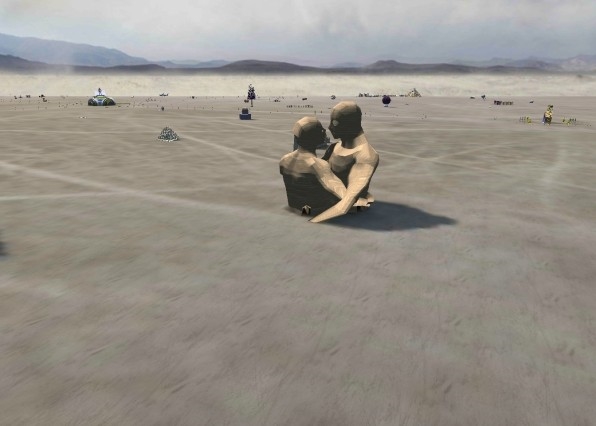
[Screenshot: Daniel Terdiman]
Second, events should take advantage of the content they normally offer. Burning Man is a place where big projects dominate. Giant whale sculptures; mobile pirate ships; a block-long New Orleans theme camp; and so on. Favorite projects live on in our memories for years. So adding to the verisimilitude of BRCvr, many of the hundreds of things you could discover as you moved around were faithful recreations of actual Burning Man projects such as the Duck art car, a giant sculpture of two human figures embracing, a well-known staff bar, and so on.
Then there’s the Man himself, whose annual burning is Burning Man’s namesake ritual. Before the Multiverse ends on Sunday, there will be a 24-hour global Man burn starting at 2 a.m. PT on Saturday. You can create and burn your own mini effigy, or simply watch as others burn theirs. You can even create a “camp” to watch with your friends.
One collective, known as We Are From Dust, worked hand in hand for weeks with a group of Burning Man artists to help bring 3D renderings of their work to BRCvr. The result was that several of my favorite all-time pieces were there to discover, including the Raygun Gothic Rocketship, a spectacular dragon art car, and—my heart be still—the Purr Pods, a group of three metal cat sculptures that purr when touched.
Just met up with some old school staffers in BRCvr at the Black Hole Bar and all marveled at how familiar it felt there- including the hugs, the jokes and the snark. I think this is the beginning of something great for Burning Man. cc @greeterdan @christaylor @cameragirlsf
— candace locklear (@clocklear) September 2, 2020
The work by We Are From Dust is representative of the third element virtual events should emulate—leveraging the creative energies of the community. Not all events are mostly participant-created like Burning Man, but all have some element of community involvement. And the benefit of leveraging that energy is that as people discover and encounter the things they love from their event, they’ll tell everyone about it. That’s exactly what’s happening in BRCvr: You stop somewhere, start talking to random strangers, and they tell you all about the amazing project they just found. And then you run off and check it out for yourself—and then tell everyone you met about it. Just like you do at Burning Man.
Lastly, events should find a way to take advantage of technology. The Multiverse project comprises many different digital environments, including Zoom discussions, 2D renderings of a virtual playa, and more. But the peak manifestation of an all-digital Burning Man alternative has been using BRCvr in a high-end virtual reality headset such as an Oculus Quest.
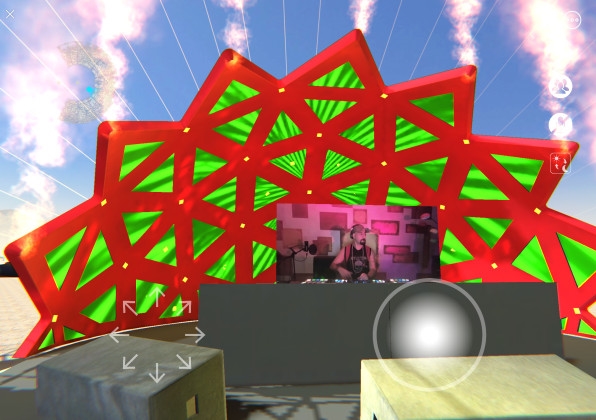
[Screenshot: Daniel Terdiman]
Although BRCvr is available in 2D on PCs or (at the very last minute) on Macs, its full riches come out when you can move around in 3D space, incorporate your hands, and see high-resolution graphics. That means using a Quest or an even more powerful VR headset.
If you have access to such gear—and it seemed many did—exploring BRCvr is a mostly seamless experience. Walking was simple. Flying was fun—note to Burning Man organizers: find a way to make flying available to everyone in the real Black Rock City—and meeting and hanging out with friends new and old was easy. Built on the AltspaceVR platform, BRCvr wasn’t without its bugs, but the richness it offered in the look and feel, the ambient sound, the beauty of the art projects, and most of all the scope and scale of the virtual playa, far outweighed any problems.
FOMO, just like on the playa
I’m the type of person that suffers from acute FOMO. And try as I might, I can’t stop myself from feeling, the minute I arrive in Black Rock City every year, that it’s already almost over, and I regret the many things I’m sure I’m going to miss seeing.
Notwithstanding my initial skepticism about BRCvr, I soon found myself realizing that I was anxious about its imminent conclusion. It is, after all, a temporary experience, something that, like Burning Man itself, forces us to reckon with impermanence, scarcity, and the inability to do everything. When I realized that BRCvr was making me feel that, it was perhaps the most profound similarity to its real-world counterpart.
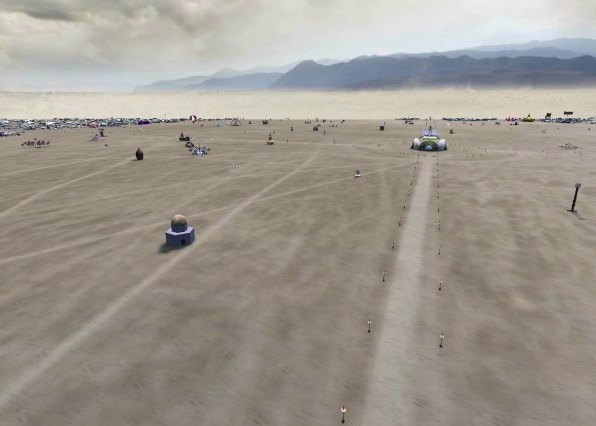
[Screenshot: Daniel Terdiman]
One night, I was hovering above the virtual playa, having clicked on a tool that sent you high into the sky. From that spot, the view was gorgeous: You could see everything, in all directions. The vastness of the playa. All the art pieces. The sunset. The mountains.
I looked over and there was someone next to me. I said hi, and she asked how I was. “I’m amazing,” I said. “I’m floating high over Black Rock City. Where else would you want to be?”
She didn’t miss a beat. “We could be in the real Black Rock City,” she said.
Indeed. But for this moment, in this pandemic era, when we’ve all spent so much time stuck in our homes, and in which burners such as me had been mourning our inability to go to Burning Man this year, this was a pretty great alternative.
Fast Company , Read Full Story
(52)

